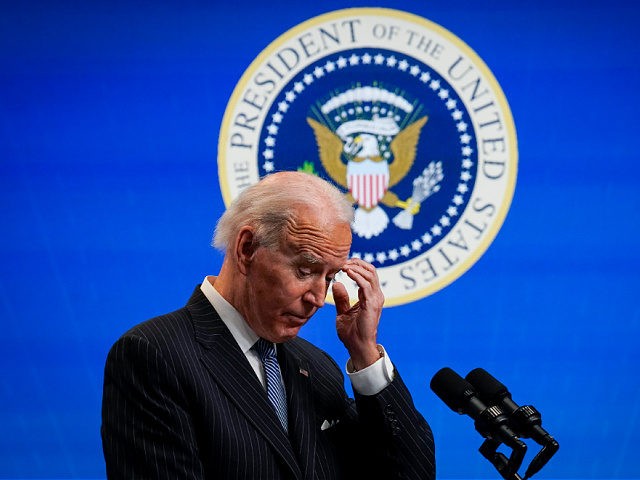CLAIM: During the State of the Union Address on Tuesday night, President Joe Biden announced that America will be rebuilt with products being manufactured and bought in America.
VERDICT: FALSE. While the president indeed has pledged to use taxpayer dollars to rebuild America’s manufacturing base, experts have deemed those goals lofty. Also, the president’s record on American-made products versus cheaper products made in China has been less-than-stellar, from his imports of Chinese PPE and his actions against American energy independence. From his Tuesday night speech:
When we use taxpayer dollars to rebuild America, we are going to do it by buying America. Buying American products to support American jobs. The federal government spends about $600 billion a year to keep this country safe and secure. There’s been a law on the books for almost a century to make sure taxpayer dollars support American jobs and businesses.Every administration says they will do it but we are actually doing it. We will buy America to make sure everything from the deck of an aircraft carrier to the steel on highway guard rails is made in America from beginning to end. All of it.
As Politico profiled last year, the president has aimed to rebuild America’s manufacturing base with taxpayer-funded initiatives that will be difficult to achieve.
His moves to tighten up “Buy American” government mandates may not be much help in meeting his administration’s overall goal of creating 5 million more jobs in “manufacturing and innovation” by the end of 2024.
His problem comes from two key factors: The vast majority of government expenditures are already for products made in America.
In addition, U.S. factory employment stood at 12.2 million workers when Biden took office — and has not exceeded 17 million since early 2001 — so bolstering employment by 40 percent in manufacturing, let alone any sector, is aggressive.
As of now, the president’s record on building and buying in America has been dismal, considering the fact that he shut down the KeystoneXL pipeline amid continued Russian oil imports and while giving “Made in China” PPE preference over “Made in America” during the pandemic. As Alliance for American Manufacturing profiled:
American mask manufacturers across the country are reporting that they are unable to compete against a flood of cheap imports from China. These masks, priced as little as a penny a mask, are made by Chinese state-owned or controlled companies and utilize unfair trade practices like heavy subsidies, currency manipulation, and lax labor and environmental laws to gain an edge.
The National Council of Textile Organizations (NCTO) also is sounding the alarm about the need to strengthen and support America’s PPE production. The organization unveiled a new video this week highlighting the work undertaken by textile makers across the country to build a domestic manufacturing base.
You know who would like to Buy American right now? Europeans who need oil and gas and want to isolate Russia.
But POTUS and climate extremists made sure they can’t do that.
— Rand Paul (@RandPaul) March 2, 2022
Glad Biden is going to buy American products in the future. Those Covid test kits that took forever to distribute came from China. Maybe Hunter made that deal and the “Big Guy” got a cut.
— Gov. Mike Huckabee (@GovMikeHuckabee) March 2, 2022
The U.S. trade deficit, wherein the cost of imported goods exceeds the value of exported goods, “mushroomed to a record in November” and will likely continue for the duration of the coronavirus pandemic. The widened gap came one month after the value of exports had a “historic gain” just one month prior in October, according to Reuters:
The goods trade deficit widened last month by 17.5% to $97.8 billion from $83.2 billion in October, Census Bureau data showed. That exceeds the previous record deficit set in September of $97 billion and may damp optimism that trade might finally add to U.S. economic growth this quarter for the first time in more than a year.
Imports rose by 4.7% with industrial supplies leading the way with an increase of $5.7 billion to $63.2 billion, followed by consumer goods rising by $2.9 billion to just shy of $67 billion as retailers rushed to fill store shelves ahead of Christmas. Both were record highs.
Goods exports, meanwhile, declined 2.1%, with weakness across the board outside of a 4.3% increase in food exports. The drop was led by declines of $1.4 billion in industrial supplies and $1.3 billion in capital goods.
Economists agree that the trade gap will continue throughout the pandemic and was likely spurred by the omicron variant.

COMMENTS
Please let us know if you're having issues with commenting.